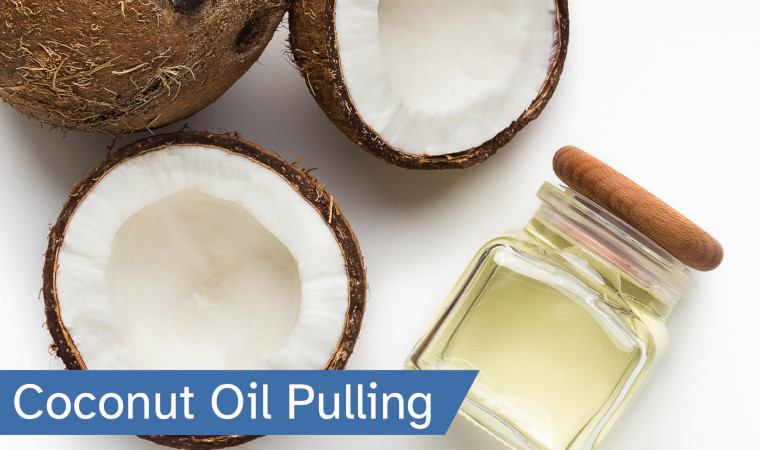In recent years, coconut oil has gained a reputation for being something of a “superfood.” Not only is it an excellent source of heart-healthy fats, but it is also loaded with nutrients and excellent for cooking. Aside from the nutrition-related benefits of this type of oil, there is another major benefit that you may not be aware of.
Coconut oil is great for oil pulling, a technique that can be used to improve dental health and prevent tooth decay. The truth is that this technique is not new – it dates back at least 3,000 years as a component of Ayurvedic medicine. If you are just hearing about this oil for the first time, however, you may want to learn a little bit more about it before you give this technique a try.
What Is Coconut Oil, and Where Do You Get It?

Coconut oil is exactly what it sounds like – an edible oil derived from coconuts. You cannot just open up a coconut and scoop out the oil, however. This type of oil is manufactured by pressing the meat of matured coconuts to extract the oil. Unlike vegetable oils, coconut oil is solid at room temperature due to its high saturated fat content. Because it is high in saturated fat, it oxidizes slowly, so it won’t go bad as quickly as vegetable oils.
This healthy oil has become very popular in recent years, so you can probably find it in the baking aisle at your local grocery store. If you can’t find it there, try a health food store or just order it online. The best kind to use is virgin coconut oil; if you really want the good stuff, look for cold-pressed virgin oil.
Step-by-Step Guide to Oil Pulling
The term “oil pulling” is a little misleading, because it doesn’t require you to physically pull anything – you will actually be swishing the oil around in your mouth. Studies have shown that pulling with coconut oil not only helps to kill the microorganisms that contribute to bad breath, but also helps protect your mouth against plaque and gingivitis. So how does it work? Follow the steps below to try this technique for yourself:

- Measure out 1 to 2 teaspoons of coconut oil onto a spoon.
- Add a few drops of therapeutic-grade oregano essential oil or a healthy mouth blend (this step is optional).
- Take the mixture by mouth and swish it around for 20 minutes.
- As you swish, the oil will mix with your saliva, and it will become thicker in consistency and milky white in color.
- When you are finished, spit the oil into the trashcan, not down the sink – you should also avoid swallowing the oil, because your body will just reabsorb the bacteria you’ve worked so hard to remove.
- Rinse your mouth thoroughly with warm water or warm saltwater.
- Brush your teeth well to remove any remaining bacteria.
If it seems like 20 minutes is a long time to you, that’s because it is. Don’t worry if you can’t make it for the full 20 minutes the first time – you may need to start with 5 minutes, then work your way up to the full 20 minutes. Swishing for 5 or 10 minutes will provide some dental benefits, but the key is to swish for the full 20 in order to break through accumulated plaque and bacteria in your mouth.
Oil pulling is not meant to be a replacement for regular dental hygiene practices, like brushing and flossing, and you should still see the dentist every six months for a routine cleaning and polishing.
Additional Benefits of Coconut Oil
This type of oil is not just great for pulling – it also contains a variety of essential nutrients and has the potential to provide other health benefits as well [1]. One tablespoon of this wonderful oil contains about 117 calories as well as 14 grams of fat. Of those 14 grams, 12 grams are saturated fat, 0.8 grams are mono-unsaturated, and 0.2 grams are polyunsaturated. At this point, you may be confused – especially if you have been led to believe that saturated fat is always bad.
The type of saturated fat found in coconut oil consists of medium-chain triglycerides (MCTs), like capric acid, lauric acid, caprylic acid, and myristic acid. Most of the fats found in your diet are likely long-chain fatty acids (LCTs), which are metabolized by the body in a very different way than MCTs. Medium-chain triglycerides are easily digested and absorbed by the body as a quick source of energy, whereas other types of fat are absorbed more slowly and stored in the body.

Not only is oil from coconuts an excellent source of fuel for the body, but it is also great for your hair and skin [2]. This type of oil helps promote healthy hair growth, and it will make your hair shiny and silky smooth. If your hair is dry or brittle due to protein loss, this wonderful oil can also help reduce that loss and restore the natural beauty of your hair.
When massaged into the skin, coconut oil acts as a powerful moisturizer, which protects your skin against dryness and flaking – it also helps reduce the appearance of wrinkles, sagging skin, and other signs of aging. This type of oil is commonly found in natural skin care products, and it can also be used as a treatment for skin problems, like eczema, psoriasis, and dermatitis.
By now, you may be wondering how it is possible that you haven’t been using coconut oil before now. Not only is it a powerful agent for promoting dental health, but it is loaded with healthy nutrients and has the potential to provide a vast number of health benefits as well. Do yourself a favor: Pick up a bottle of cold-pressed virgin coconut oil today and get started with oil pulling and other beauty regimens using this powerful superfood.
References:
[1] https://www.healthline.com/nutrition/top-10-evidence-based-health-benefits-of-coconut-oil
[2] https://www.medicalnewstoday.com/articles/coconut-oil-good-for-skin

